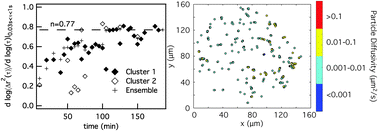Quantifying the dynamic transition of hydrogenated castor oil gels measured via multiple particle tracking microrheology†
Abstract
Rheological modifiers are essential ingredients in commercial materials that exploit facile and repeatable phase transitions. Although rheological modifiers are used to change flow behavior or quiescent stability, the complex properties of particulate gels during dilution is not well studied. We characterize a dynamically evolving colloidal gel, hydrogenated castor oil (HCO), a naturally sourced material, used in consumer products. This HCO scaffold consists of fibrous colloids, a surfactant (linear alkylbenzene sulfonate) and water. The gel undergoes critical transitions, degradation and formation, in response to an osmotic pressure gradient. Multiple particle tracking microrheology (MPT) measures the evolving material properties. In MPT, fluorescent probe particles are embedded into the sample and Brownian motion is measured. MPT data are analyzed using time-cure superposition, identifying critical transition times and critical relaxation exponents for degradation and formation where tc,deg = 102.5 min, ndeg = 0.77 ± 0.09, tc,for = 31.9 min, and nfor = 0.94 ± 0.11, respectively. During degradation and formation HCO gels evolve heterogeneously, this heterogeneity is characterized spatially and temporally. Heterogeneity of the gel is quantified by comparing variances of single particle van Hove correlation functions using an F-test with a 95% confidence interval. HCO transitions have rheological heterogeneous microenvironments that are homogeneously distributed throughout the field of view. Although HCO gels do evolve heterogeneously, this work determines that these heterogeneities do not significantly change traditional MPT measurements but the analysis techniques developed provide additional information on the unique heterogeneous scaffold microenvironments. This creates a toolbox that can be widely applied to other scaffolds during dynamic transitions.


 Please wait while we load your content...
Please wait while we load your content...